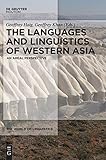The Languages and Linguistics of Western Asia : An Areal Perspective / ed. by Geoffrey Haig, Geoffrey Khan.
Material type: TextSeries: The World of Linguistics [WOL] ; 6Publisher: Berlin ; Boston : De Gruyter Mouton, [2018]Copyright date: ©2019Description: 1 online resource (VIII, 978 p.)Content type:
TextSeries: The World of Linguistics [WOL] ; 6Publisher: Berlin ; Boston : De Gruyter Mouton, [2018]Copyright date: ©2019Description: 1 online resource (VIII, 978 p.)Content type: - 9783110426083
- 9783110421743
- 9783110421682
- 400
- P381.M53 L36 2019
- online - DeGruyter
- Issued also in print.
| Item type | Current library | Call number | URL | Status | Notes | Barcode | |
|---|---|---|---|---|---|---|---|
 eBook
eBook
|
Biblioteca "Angelicum" Pont. Univ. S.Tommaso d'Aquino Nuvola online | online - DeGruyter (Browse shelf(Opens below)) | Online access | Not for loan (Accesso limitato) | Accesso per gli utenti autorizzati / Access for authorized users | (dgr)9783110421682 |
Frontmatter -- Acknowledgements -- Table of contents -- 1. Introduction -- 2. Eastern Anatolia and northwestern Iran -- 2.1. Eastern Anatolia and northwestern Iran: overview -- 2.2. The Armenian dialects -- 2.3. Northern Kurdish (Kurmanjî) -- 2.4. The Arabic dialects of eastern Anatolia -- 2.5. The Neo-Aramaic dialects of eastern Anatolia and northwestern Iran -- 3. Northern Iraq -- 3. Northern Iraq -- 3.2. The Arabic dialects of northern Iraq -- 3.3. The Iranian languages of northern Iraq -- 3.4. The Neo-Aramaic dialects of northern Iraq -- 3.5. Iraq-Turkic -- 4. Western Iran -- 4.1. Western Iran: overview -- 4.2. The Turkic varieties of Iran -- 4.3. Bakhtiari -- 4.4. The Neo-Aramaic dialects of western Iran -- 4.5. Hawrāmī of western Iran -- 4.6. Persian -- 4.7. Kumzari -- 5. The Caspian region and south Azerbaijan: Caspian and Tatic -- 6. Caucasian rim and southern Black Sea coast -- 6.1. Caucasian rim and southern Black Sea coast: overview -- 6.2. Laz -- 6.3. Ossetic -- 6.4. Romeyka -- 7. Appendix: Basic lexical items in selected languages of Western Asia -- Index of language names -- Index of place names -- Index of subjects
restricted access online access with authorization star
http://purl.org/coar/access_right/c_16ec
The languages of Western Asia belong to a variety of language families, including Indo-European, Kartvelian, Semitic, and Turkic, but share numerous features on account of being in areal contact over many centuries. This volume presents descriptions of the modern languages, contributed by leading specialists, and evaluates similarities across the languages that may have arisen by areal contact. It begins with an introductory chapter presenting an overview of the various genetic groupings in the region and summarizing some of the significant features and issues relating to language contact. In the core of the volume the presentation of the languages is divided into five contact areas, which include (i) eastern Anatolia and northwestern Iran, (ii) northern Iraq, (iii) western Iran, (iv) the Caspian region and south Azerbaijan, and (v) the Caucasian rim and southern Black Sea coast. Each section contains chapters devoted to the languages of the area preceded by an introductory section that highlights significant contact phenomena. The volume is rounded off by an appendix with basic lexical items across a selection of the languages. The handbook features contributions by Erik Anonby, Denise Bailey, Christiane Bulut, David Erschler, Geoffrey Haig, Geoffrey Khan, Rene Lacroix, Parvin Mahmoudveysi, Hrach Martirosyan, Ludwig Paul, Stephan Procházka, Laurentia Schreiber, Don Stilo, Mortaza Taheri-Ardali, Christina van der Wal Anonby.
Issued also in print.
Mode of access: Internet via World Wide Web.
In English.
Description based on online resource; title from PDF title page (publisher's Web site, viewed 25. Jun 2024)


